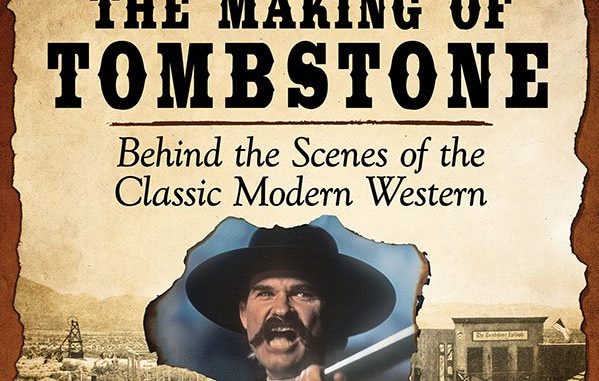

Review Fix chats with author John Farkis, who lets us know why his inside look at the making of one of the best Western films of all-time is a worthy addition to your book collection.
About the Book:
The day-by-day inside story of the making of Tombstone (1993) as told to the author by those who were there—actors, extras, crew members, Buckaroos, historians and everyone in between. Historical context that inspired Kevin Jarre’s screenplay is included. Production designers, cameramen, costume designers, composers, illustrators, screenwriter, journalists, set dressers, prop masters, medics, stuntmen and many others share their recollections—many never-before-told—of filming this epic Western.
About John Farkis:
Retired automotive executive John Farkis, is an historian and lifelong fan of the cinema. His work has appeared in newspapers, magazines and on NPR and other radio programs. He lives in South Lyon, Michigan.
Review Fix: How did this project start for you?
John Farkis: After having written several books on John Wayne, and the making of the Alamo, given several presentations and lectures, written articles for newspapers and magazines, had numerous book signings, and been involved in several celebrations, to be honest, I was all Alamo’d out. However, during my Wayne research at Old Tucson Studios, I came across several interesting files on the filming of Tombstone, and as this was my favorite Western film along with The Wild Bunch, it only seemed logical that I write a book on the subject.Â
Review Fix: Any challenges during the writing process?
Farkis: As you may already know, scripts are not necessarily shot sequentially. Actors availability, weather, interior vs. exterior shots, day and night shooting, locations vs. sound stage filming, etc., all play a role in when a specific scene or sequence is filmed. As I tried to detail the shooting schedule on an almost day by day basis, it was required to determine what was shot when and where. In addition, as Kevin Jarre, the original director, was fired after a month’s filming, most of his footage was reshot by his replacement, George Cosmatos. Again, scenes, dialog, content, and locations were also changed and it became exceedingly difficult to determine exactly what was done where. Combine that with actors interview availability, and you can see what a challenge it could be.
Review Fix: Why does Tombstone matter?
Farkis: Tombstone is one of the most historically accurate depictions of the events surrounding the gunfight at the OK Corral. Granted, George Cosmatos took a great deal of liberties in condensing various events to fit into a two-hour time frame; ie. Virgil and Morgan were not both shot on the same evening, the number of Cowboys killed during Earp’s Vendetta ride was greatly inflated, Doc did not kill Ringo. But, overall, the story is fairly accurate. Combine the crisp dialog with historically accurate weapons, saddles, costumes and settings, and you get a film that, more than others, shows exactly what life was like in 1881 Tombstone. Throw in Val Kilmer’s and Michael Biehn’s Oscar-worthy performances and it’s no wonder that Tombstone significantly out-grossed Kevin Costner’s Wyatt Earp by a more than two-to-one margin.
Review Fix: What’s your background in film critique?
Farkis: Actually, I was an executive in a Fortune 100 automotive supply company before I retired. But, over the years, I’ve had the great opportunity and privilege to network with literally hundreds of folks in the entertainment industry, both in front of and behind the camera, expanding my knowledge with each relationship. I wasn’t afraid to ask questions and folks were more than willing to share their replies. When I think back on some of my initial questions, I just shudder at the thought. But, as they say, “That’s how you learn. By asking.” And, on top of that, I’ve had the great pleasure of many new lasting friendships.
Review Fix: Who’s your favorite element of the film? Why?
Farkis: If you’re asking who is my favorite actor, hands down, it has to be Michael Biehn. His portrayal of Johnny Ringo is absolutely brilliant. You can literally see his maniacal transformation during the shoot out scene with Kilmer. Vastly underappreciated, his performance takes a back seat to Val Kilmer’s Doc Holliday. But, for my money, it’s every bit as good as Kilmer’s. Now, if you’re asking what element of the film impresses me the most, it has to be the costuming and authenticity. Prior to Tombstone, most Westerns looked alike. Weather-beaten buildings, brown and gray in appearance, dull, drab costumes, etc,. Tombstone was an alive, busting at the gut, town, newly constructed and expanding every day. Citizens wore Victorian clothing, decked out in fancy clothes and bright colors. And the film made every attempt to show what the real West actually looked like. Weapons, saddles, spurs, chaps, and hats were all period correct. In many cases, the same model weapon the historical figures used were actually used by the actors playing that character. And, contrary Costner’s Wyatt Earp, buscadero tie-down holster rigs were not used back then.
Review Fix: What are your goals for the book?
Farkis: This project was a labor of love. My intent is and was to share my love of both the West and the cinema with the reader. I hope they enjoyed reading it as much as I did writing it. Sometimes the backstories are just as interesting as the film itself, and I tried to share as much of the actual making of the film as I could. Specifically with regard to Tombstone, there were so many rumors and falsehoods floating around as to who did what, what was shot, the tone of the set, where scenes were filmed, etc. that I thought it would be both interesting and beneficial to set the record straight. Based on sales so far, and various reviews, I guess I accomplished that.
Review Fix: What’s next?
Farkis: It’s a secret. But, I can say if you love the type of books I write, and the specific genre, you’ll be pleased with my next effort.


Leave a Reply